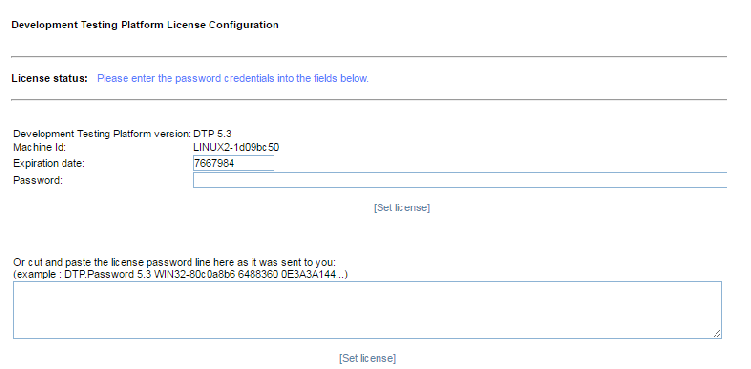You must license Development Testing Platform after installation.
- Open a Web browser and enter http://hostname in the address bar to access the authorization page (http://hostname:8080 for Linux installations).
- If you cannot see the Authorization page, it might indicate that port 80 on Windows or 8080 on Linux is being used by another application. If this is the case, you should reconfigure the server port. See Reconfiguring DTP Ports (Optional). After re-configuring the port, return to the authorization page and resume installation with the following steps.
Enter admin in the User and Password fields and click Log in; you will be directed to the License Configuration page.
Important
For security purposes, you should change the default administrator password (admin). See the User Administration for information on editing user profiles.
- Enter the License code that you received from your Parasoft representative and click Set License.
If you do not have the license code:
- Email your Machine ID to your Parasoft account representative.You will have to wait until you receive the License Server key from your Parasoft representative to continue installing DTP.
- Copy and paste the license key received from your Parasoft account representative into the Password field on the License Configuration page.
- Click Set License.
You will be directed to the first enabled component. Components are automatically enabled based on the license configuration.
Enabling a HASP Key License
Parasoft products are licensed per a unique machine identifier called a machine ID. DTP supports licensing via USB HASP key, which enables DTP to generate the same machine ID for Parasoft systems connected to DTP while the key is plugged in. Contact your Parasoft representative for more information on HASP key licensing.
Support for USB HASP keys is available on Windows and Linux.
Enabling a HASP Key License for Windows
- Stop DTP Server and Data Collector services (see Stopping DTP Services).
- Open the variable file (no extension) located in the [DTP_HOME]/bin directory in an editor.
- In the
DTP_JAVA_OPTSandDC_JAVA_OPTSvariables, change the-DuseExternalLockflag fromfalsetotrue. - Insert the USB HASP key and wait for the operating system to install the drivers; the LED on the HASP key flashes during installation.
- After the drivers have been installed, Start DTP and Data Collector services.
- Add the new license; see Using License Server.
Enabling a HASP Key License for Linux
- Run
dtpconsole.shlocated in the [DTP_HOME]/bin directory. - Use the console to stop DTP Server and Data Collector services (see Stopping DTP Services).
- Open the variable file (no extension) also located in the [DTP_HOME]/bin directory in an editor.
- In the
ENABLE_EXTERNAL_LOCKvariable, change the-DuseExternalLockflag fromfalsetotrue. - You must also change how Linux handles the USB HASP key hardware. By default, USB devices have 66* permission, but the USB HASP key requires 666 permission.
- Locate the udev.rules file for your distribution. This file is responsible for USB devices.
- Modify the
usb_deviceentry to useMODE="0666" - Execute the following command:
udevadm control --reload-rules
- Plug the USB HASP Key into the machine; if the key is already plugged in, run following command as root user to programmatically insert key:
udevadm trigger - Start DTP services from the DTP console.
- Add the new license; see Adding and Managing Licenses.
Next Steps
After installing and licensing DTP, you may be directed to the database creation page. See Preparing the Database Table Structure for instructions on how to proceed.
If you installed the DTP distribution that includes an embedded database server (Windows and Linux only), you can begin working with DTP immediately.

